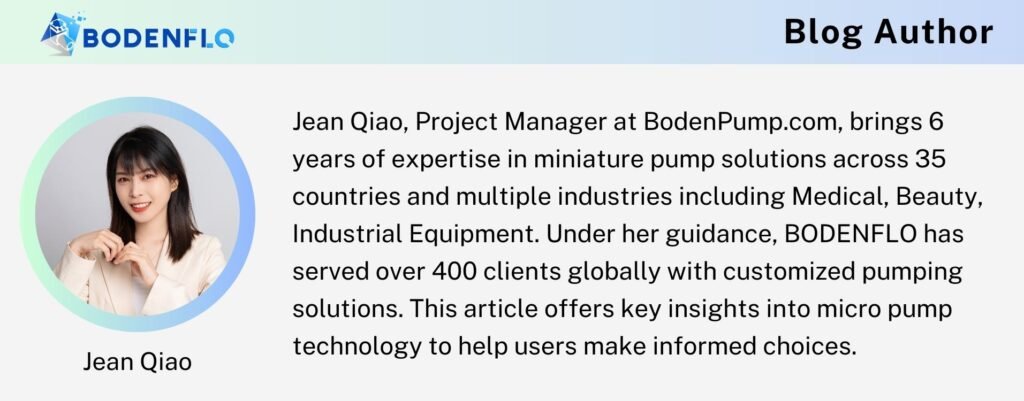
Many customers who buy miniature diaphragm gas pumps, vacuum pumps, and liquid pumps are not sure how to choose a diaphragm. It will have questions about the pump bought, not clear whether it is suitable for pumping gas & liquid or not. But is it really difficult to choose?
The answer is: no. The three common diaphragm materials are EPDM, PTFE, FKM.
This article will continue to talk to you about diaphragms in the following ways.
Miniature diaphragm pumps rely on the reciprocating motion of the diaphragm in the pump body to inhale and discharge gas.
The diaphragm is a very important component of the pump body, it is the performance of the pump that has a great impact.
Diaphragm life is mainly reflected in several aspects, bending life, corrosion resistance, resistance to high and low-temperature performance.
Therefore, to meet the above requirements of the diaphragm material range is greatly reduced, the diaphragm membrane industry is currently the most used, the most mature have the following rubber: EPDM, PTFE, FKM, NBR, etc...
EPDM (Ethylene Propylene Diene Monomer)
EPDM rubber is a copolymer of ethylene, propylene, and a small amount of non-conjugated diolefins.
The main chain is composed of chemically stable saturated hydrocarbons and is the lightest common rubber in terms of raw rubber density.
Performance characteristics
- Ageing resistance
resistance to ozone, UV, and other aging properties.
chemical resistance: good resistance to weak acids, alkalis, alcohols, and ketones.
- Chemical resistance
Good resistance to weak acids, alkalis, alcohols, and ketones.
Excellent resistance to water, water vapor, and radiation.
- Insulation
High volume resistivity, breakdown voltage 30 to 40 MV/m, which effectively reduces the effects of static electricity, etc., caused by friction.
- Applicable temperature
Minimum use temperature -40 ~ -60 ℃, can be used under 130 ℃ for a long time.
(diaphragm material can be applied at this temperature, does not mean that the pump can also be used at this temperature, the use of the pump temperature by the motor, diaphragm, cavity material and other components of the integrated impact)
- Application areas
in automotive parts, construction materials, seals, and other fields of use more widely.
PTFE (Polytetrafluoroethylene)
PTFE, also known as "Teflon", is a polymer compound made from PTFE by the polymerization and is one of the best corrosion-resistant materials in the world today.
Performance characteristics
- Ageing resistance
Non-hygroscopic, non-combustible, extremely stable against oxygen and ultraviolet light, with excellent weather resistance.
- Chemical resistance
Resistant to aqua regia and most organic solvents, even if boiled in aqua regia, its quality and performance are unchanged, corrosion resistance is excellent, but not resistant to radiation, radiation is easy to cause degradation, the electrical properties of the polymer, mechanical properties are significantly reduced, so the nuclear power plant waste gas sampling pump diaphragm used to EPDM material.
- Insulation
Breakdown voltage, volume resistivity, arc resistance are high, is the ideal insulating material; applicable temperature: in -196 ~ 260 ℃ in a wide range of temperature are to maintain excellent mechanical properties, not brittle at low temperatures, still maintain good flexibility.
- Volumetric deformation rate
It is a typical soft and weak polymer, the mutual gravitational force between macromolecules is small, the stiffness, hardness, and strength are small, and deformation will occur under prolonged stress.
Note: According to the list of carcinogens of the International Agency for Research on Cancer (IARC) of the World Health Organisation, PTFE is a carcinogen of category 3, i.e. its carcinogenic effect on humans is not yet known.
- Application areas
In the petrochemical and metallurgical industry, pipelines, pumps, valves, and other equipment that require corrosion protection are used extensively, as coating and impregnating materials, in the textile, medical, chemical, and electrical fields are widely used.
FKM (Viton)
FKM is polymerized with fluorine atoms in the carbon bonds of the main or side chains, and there are many derivatives of FKM with a wide range of properties.
Performance characteristics
- Ageing resistance properties
Excellent resistance to weathering and long-term use even in environments with high ozone concentrations.
- Chemical resistance
Chemically stable, resistant to most organic and inorganic solvents, as well as most petroleum-based oils, but not to low molecular ketones, ethers, esters, ammonia, etc.
Intolerance to radiation, easy to crack after irradiation, with a relatively significant decrease in structural strength.
- Insulation
Low hygroscopicity, good insulating properties.
- Applicable temperature
Resistant to certain high temperatures retain high mechanical strength at 200°C but have a certain volume deformation.
- Application areas
In the chemical industry as seals, can be used to seal all kinds of organic solvents, in the petrochemical industry as wire and cable insulation materials, higher oil resistance and wear resistance, in the automotive engine industry, is also more widely used.
BODEN Pumps Diaphragm types
Our diaphragms for air and liquid pumps are mainly made of EPDM and have good resistance to low corrosive, weak acid, and alkaline media.
When pumping more serious corrosion or needing to achieve the specified anti-corrosion level of media, we recommend the use of PTFE diaphragms.
Diaphragms made of FKM can also be customized for special media, contact our engineers for customization requirements.


